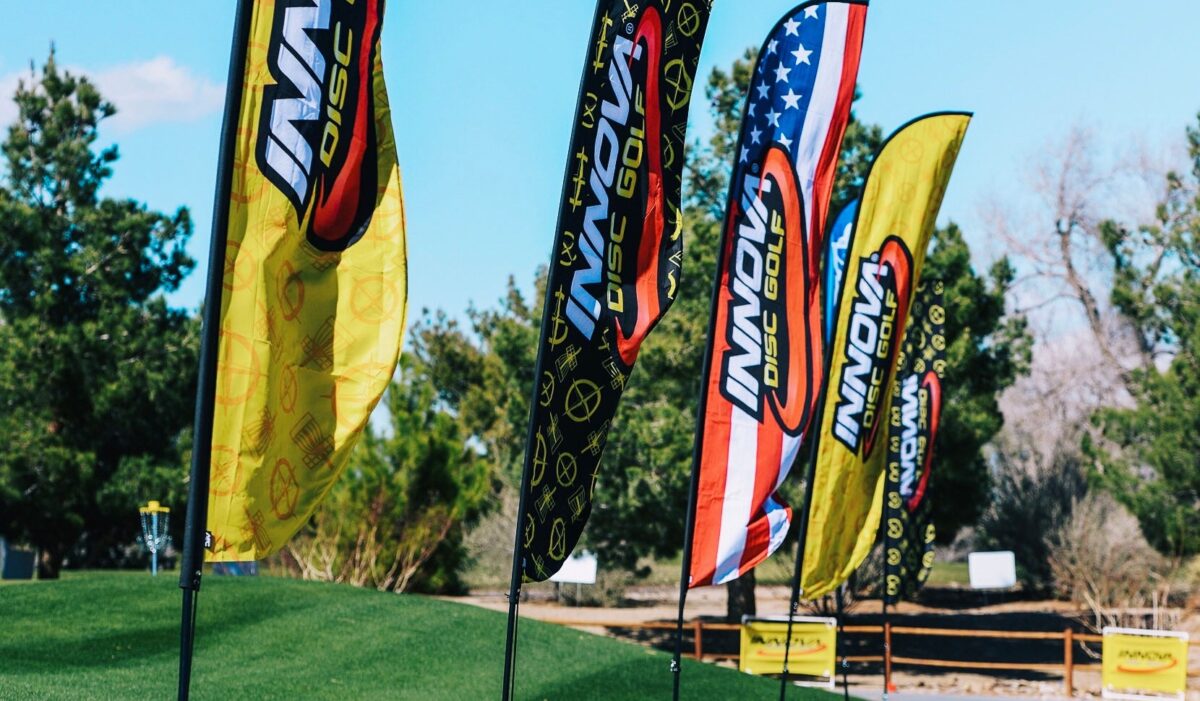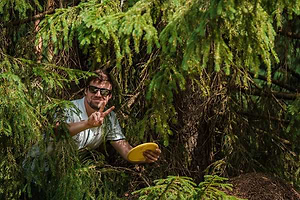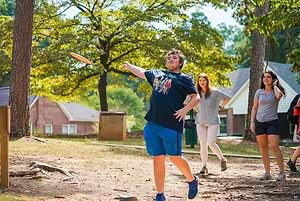Don’t Blow It! How to Play Disc Golf in the Wind
TOC
Table of Contents
How to Play Disc Golf in the Wind
Playing disc golf in the wind can either be fun or very frustrating. How it goes for you depends on your preparation. If you treat it like any other calm weather round, you’re in for a long day. But, if you plan each shot based on wind tips you’ve learned and perfected in practice, it’ll be much smoother sailing. The following article will breakdown why it’s important to take wind seriously, the different kinds of wind that come into play, and tips on how to read and throw with heavy wind present.
The Effect of Wind on Disc Flight
Flying discs are significantly affected by the wind speed and direction. Wind affects ground play too. Discs are more likely to skip in unexpected ways or roll away. Even the simplest lay-up putts can be tricky when it’s really windy! For the purpose of this article, we are going to assume the wind is blowing around 20 MPH (32 KPH). This is pretty strong wind by disc golf standards, and it will definitely affect your play. However, it’s not so much to be deemed unplayable.
Headwinds
Let’s start by talking about headwind conditions (also known as upwind). A 20 MPH headwind will dramatically change how you want to approach your drives, upshots and putts compared to calm conditions. Here is how a headwind will affect your disc flight:
- Less Stability—Headwinds typically accentuate the turn rating of a disc golf disc by mimicking a faster flight speed. An overstable disc will tend to fly straighter or maybe flip over a little bit. An understable to stable disc may turn over a lot and be hard to control.
- More Drag—Headwinds are pushing against a flying disc, which creates more drag and will limit distance.
- More Lift—Slower discs like putters and mid-ranges will generally experience more lift as the headwind gets underneath the disc. Nose-up throws with any speed disc will stall out in the air and lose distance.
For more details on why discs do what they do, take a look at our Science Behind Disc Golf Flight blog.

How to throw with a headwind
For strong headwind conditions, you will want to choose overstable discs with heavier weights. These will fight the wind and cut through it better. You will also want to try and release the disc as flat as possible (in terms of both nose angle and hyzer angle). These tips will help you get more consistent and controllable flights when throwing straight into a strong wind.
Tailwinds
On the opposite end of the spectrum we have tailwinds. Strong tailwind conditions can be fun. Just ask David Wiggins, Jr., who set the world distance record of 1108 feet with an Innova Boss in an extreme tailwind out in the desert. Throwing with a tailwind (or downwind) can help you add more distance, but it is still not easy to control your disc flight. Here’s how a tailwind can affect your disc golf discs:
- More Stability—Opposite of a headwind, a tailwind actually mimics a slower flight speed. This accentuates the fade rating of the disc and will make it fly more overstable than the flight numbers suggest.
- Less Glide—Contrary to popular belief, downwind conditions actually reduce the glide of a disc. More distance can be achieved with the right angles and speeds, but it takes skill, practice and good disc selection.
- Less Drag—The reason downwind throws can go farther is because the drag on the disc is reduced. It’s not having to fight the wind as much.
How to throw with a tailwind
When throwing in a strong tailwind, you will generally want to use a more understable disc. Overstable discs will tend to fade out quicker, while understable discs can better ride the wind and generate more turn. A more nose-down release angle will also benefit you in the wind if trying to achieve more distance. That exposes the bottom of the flight plate to the wind. Throwing too much nose-up will tend to get the disc smashed down sooner by a tailwind. A lower weight may also help or hurt depending on what you are trying to achieve. It may help add more distance off the tee, but be much harder to control on touchy approach shots or putts.
Crosswinds
Last but certainly not least, let’s look at crosswinds. This is where things get really tricky for us disc golfers because there are a wide variety of crosswind conditions. You might have wind coming straight across the fairway from one side or the other. Or, it could be a head-cross or tail-cross coming over one of your shoulders. Each slight change in direction can affect disc flight differently. For this example, we will use a right-hand backhand (RHBH) player throwing a relatively neutral-stability disc. This is how each wind direction can impact a disc golf throw:
- Cross Left to Right Wind: Will generally hold the disc straighter for longer. Hyzers may get smashed down, while anhyzers may experience more turn.
- Cross Right to Left Wind: Acts the opposite of above. Hyzers will get pushed further left. Anhyzers can get smashed down as the top side of the disc is exposed to the wind direction.
- Tailwind Left to Right: Will keep a RHBH hyzer a little straighter and add a bit of stability to an anhyzer shot.
- Tailwind Right to Left: Hyzer shots will experience more lift and want to finish further left. Anhyzers will get a little more turn at first, but will usually stable out at the end (depending on the disc).
- Headwind Left to Right: Hyzer shots will hold straighter, but can be smashed down if given too much angle. Anhyzers will get more turn.
- Headwind Right to Left: Hyzer shots will gain more lift and stability, but can stall out if thrown too nose-up. Anhyzers will turn over a lot and can be harder to control, especially if throwing an understable disc.
These are general rules of thumb for RHBH (Right hand backhand) throwers. You can reverse the descriptions above when throwing left hand backhand or forehand with the opposite disc rotation. Of course, the disc’s speed, stability rating, weight, hyzer angle and nose angle will all affect how it flies in different wind directions. Crosswinds can be much harder to figure out than straight headwinds or tailwinds. The best advice is to go out and do some field work on a windy day. Throw different discs on different angles and in different directions in the field. This will help you get a better understanding of what might work best for you during a real round.
How Do I Gauge Wind Speed and Direction?
Judging the direction of the wind can be tricky, especially when it is swirling around a natural environment. Sometimes the wind will change direction or strength in unpredictable ways. This is out of your control. As a disc golfer, you have to to make your best judgments and feel confident in your decisions out on the disc golf course. Throw a few grass clippings in the air or kick up some dust off the ground near the tee pad of your lie. These are a couple ways to get a sense of wind direction and speed before you throw.
Left your portable wind guage equipment at home? You’re in luck… There’s a visual method for gauging the wind called the Beaufort Scale that’s been around since 1805. This may prove to be a handy reference the next time your facing blustery conditions.
Adjusting your Throws for Windy Conditions
You will have to adjust your approach when playing disc golf in windy conditions. The stronger the wind, the more you’ll have to adjust your game and disc selection. Here are a few tips to help you get started:
Disc golf shots in a headwind
- Driving in a Headwind—Use faster, heavier and more overstable discs with a flat release or some anhyzer.
- Approach Shots in a Headwind—Use overstable fairway drivers, midranges or putters to have more control and accuracy.
- Putting in a Headwind—Keep putts low and flat. Use more overstable putters. Mind your nose angle (nose-up will lift in a headwind, while nose-down will drop). Play it safe with a lay-up if you aren’t confident putting in a strong headwind. You might even try lobbing the disc upside down to ensure it stays close to the basket.
Disc golf shots in a tailwind
- Driving in a Tailwind—Use understable discs for more distance, but understand tailwind flight characteristics depending on the shot shape you are trying to throw. You may still opt for an overstable disc if you need to throw a spike hyzer.
- Approach Shots in a Tailwind—Disc selection may vary based on the shot and distance. Just remember the tailwind will make the disc more stable and it will reduce glide, so keep that in mind when planning and executing your shot.
- Putting in a Tailwind—Nose-up putts will drop quickly, so you can aim higher. Nose-down putts will tend to lift, so you have to be careful if you don’t want the disc to drift too far past the basket on a miss.
Disc golf shots with a crosswind
- Driving in a Crosswind—Do your best to understand the wind direction. Think about your disc selection, nose angle and hyzer angle and how both sides of the disc (top and bottom) will be exposed to the wind.
- Approach Shots in a Crosswind—Again, the disc’s flight characteristics and release angles will affect your upshot strategy. Consider more overstable approach discs with less glide in heavy winds. These will provide more control and consistency.
- Putting in a Crosswind—Be extremely aware of the wind direction and your release angles. A hyzer putt in a head on right to left wind will want to lift up and drift hard to the left. Flatter is generally better in all wind conditions, especially if you are a little unsure of your shot.
Best Discs For Windy Conditions
Disc selection is critical in high-wind conditions. Bag some overstable discs for controllable shots into the wind. Bag some understable discs for tailwind throws. Here are some of Innova’s best wind discs that we recommend:
Best Driver Discs for the Wind
- Headwind—The Innova Firebird is one of the best headwind discs out there. The 9-speed design is easier to control than something faster and the overstability of this mold will really fight hard into a wind. Star, Halo and Champion plastic will over the most stability.
- Tailwind—Innova has a lot of great tailwind discs. We recommend a Leopard3 if you want something that will give you better control as a 7-speed fairway driver. If you want to go full distance, a Mamba, which is very understable, is a great downwind bomber.
Best Midrange Discs for the Wind
- Headwind—The Innova Toro was co-designed with Calvin Heimburg to be a reliable overstable upshot disc. It can handle a lot of torque and is great in a stiff headwind.
- Tailwind—Here, we recommend a Mako3. This understable mid-range disc will give you a nice straight flight when throwing in a tailwind.
Best Putt & Approach Discs for the Wind
- Headwind—We’re with Big Jerm on this choice. He loves his AviarX3 and it’s a great putter for headwind putts and controlled approach shots.
- Tailwind—A classic Aviar is a great choice for tailwind putts. The wind will push the disc straight and keep it from dropping too quickly. If you are a nose-down putter, you may want to choose something a little more stable like a Firefly.
Mental Game In the Wind
Playing in really windy conditions can test your patience. It isn’t always easy to play in the wind and keep your cool. It takes a strong mental game. You need to know when you can be aggressive. You must also know when you should be conservative. Sometimes, laying up for a sure bogey is smarter than running a putt and taking a much bigger number. Here are a few mental game tips for when you play in the wind.
- Visualize Your Shots—Take a little time before you throw to visualize your shot and think about how the wind direction and speed will affect your disc flight.
- Adjust Your Expectations—You can expect at least a few extra strokes when playing disc golf in windy conditions. Reset your expectations and this will help you minimize the frustration throughout your round.
- Reset After a Bad Hole—This is always a good tip for any disc golfer. You will have some bad shots and holes when playing in the wind. Forget about it, move onto the next shot/hole and learn from your mistakes.
- Have Fun—You can’t control the wind and it will make your round more of an adventure. Sometimes, you simply have to embrace the chaos and have fun!
Tips For Playing on a Windy Day
- Use Wind Indicators: Toss a few blades of grass in the air or kick up some dirt near your lie. These can help you determine wind direction and speed before you plan your shot.
- Play More Conservatively: The best wind players know when to play it safe or lay up. A more conservative approach usually works out better in windy conditions.
- Use Slower Discs: Faster drivers can cut through the wind better, but will be much harder to control. Consider slower fairway drivers and mids. Sacrifice a little distance for a lot more control.
- Play for Pars: When it’s really windy on a disc golf course, par is generally a good score. Take your birdies when you can. Otherwise, play for more pars and you will be competitive in most divisions.
- Practice in The Wind: Before facing an entire round in conditions and scenarios you haven’t faced before, pick a windy day to throw some shots in an open field. Throw upwind, then retrieve your throws and throw downwind. This will give you a better sense for how to adjust your discs and your throws during a round.
Check out our How Weather Can Affect Disc Selection blog, for further tips on inclement weather play.
Questions & Answers:
How much wind is too much disc golf?
This is a personal question. Some disc golfers won’t go to the course if it’s more than 10 MPH. Others will play in the middle of a tornado if they can. Once you start getting beyond 20 MPH, realize the conditions will get significantly tougher and scores will be higher. This is where you need to adjust your scoring expectations and strengthen your mental game.
How windy is too windy for ultimate frisbee?
Disc golf and ultimate are two very different sports. Ultimate discs are greatly affected by strong winds. Again, it’s up to your group and each individual player to determine when too much wind is too much to play.
Personalized Disc Recommendations
Just answer a few questions and we’ll send you personalized recommendations within 24 hours.
GET PRO TIPS


